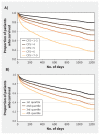Complementing chronic frailty assessment at hospital admission with an electronic frailty index (FI-Laboratory) comprising routine blood test results
- PMID: 31907228
- PMCID: PMC6944299
- DOI: 10.1503/cmaj.190952
Complementing chronic frailty assessment at hospital admission with an electronic frailty index (FI-Laboratory) comprising routine blood test results
Abstract
Background: Acutely ill and frail older adults have complex social and health care needs. It is important to understand how this complexity affects acute outcomes for admission to hospital. We validated a frailty index using routine admission laboratory tests with outcomes after patients were admitted to hospital.
Methods: In a prospective cohort of older adults admitted to a large tertiary hospital in the United Kingdom, we created a frailty index from routine admission laboratory investigations (FI-Laboratory) linked to data comprising hospital outcomes. We evaluated the association between the FI-Laboratory and total days spent in hospital, discharge to a higher level of care, readmission and mortality.
Results: Of 2552 admissions among 1750 older adults, we were able to generate FI-Laboratory values for 2254 admissions (88.3% of the cohort). More than half of admitted patients were women (55.3%) and the mean age was 84.6 (SD 14.0) years. We found that the FI-Laboratory correlated weakly with the Clinical Frailty Scale (CFS; r 2 = 0.09). An increase in the CFS and the equivalent of 3 additional abnormal laboratory test results in the FI-Laboratory, respectively, were associated with an increased proportion of inpatient days (rate ratios [RRs] 1.43, 95% confidence interval [CI] 1.35-1.52; and 1.47, 95% CI 1.41-1.54), discharge to a higher level of care (odd ratios [ORs] 1.39, 95% CI 1.27-1.52; and 1.30, 95% CI 1.16-1.47) and increased readmission rate (hazard ratios [HRs] 1.26, 95% CI 1.17-1.37; and 1.18, 95% CI 1.11-1.26). Increases in the CFS and FI-Laboratory were associated with increased mortality HRs of 1.39 (95% CI 1.28-1.51) and 1.45 (95% CI 1.37-1.54), respectively.
Interpretation: We determined that FI-Laboratory, distinct from baseline frailty, could be used to predict risk of many adverse outcomes. The score is therefore a useful way to quantify the degree of acute illness in frail older adults.
© 2020 Joule Inc. or its licensors.
Conflict of interest statement
Competing interests: Kenneth Rockwood asserted copyright of the Clinical Frailty Scale (CFS) through Dalhousie University, Halifax; the CFS is freely available for research, educational and use by not-for-profit health care. He is President, Chief Science Officer and founder of DGI Clinical. He has received personal fees for guest lectures and academic symposia from Cape Breton University; Centre de recherche institut universitaire de gériatrique de Montréal; The Jackson Laboratory, Bar Harbor, Maine; MouseAGE meeting, Rome, Italy; Frontotemporal Degeneration Treatment Study Group; and SunLife Insurance, Japan. He also received personal fees for attending an advisory board meeting at Lundbeck. No other competing interests were declared.
Figures


References
-
- Hubbard RE, Peel NM, Samanta M, et al. Frailty status at admission to hospital predicts multiple adverse outcomes. Age Ageing 2017;46:801–6. - PubMed
Publication types
MeSH terms
Grants and funding
LinkOut - more resources
Full Text Sources
Medical
